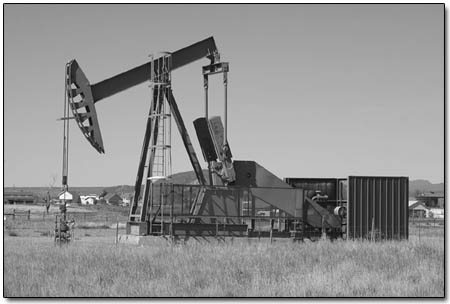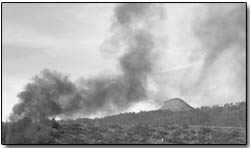|
Task force tries to get a grip on area's high
ozone levels
by Will Sands
 |
| Compressors used to extract
gas from wells, such as this one in La PLata County, are at
least partially to blame for the area’s ozone pollution
woes. A study commissioned by the New Mexico Department of
Environment on the San Juan Basin’s air quality is due
out in a couple weeks./Photo by Missy Votel. |
Air pollution is becoming a growing concern for La Plata County.
And while increased local traffic and particulates from things
like dust and coal smoke may seem like obvious culprits, industry
predominantly in northern New Mexico is beginning to impact the
quality of La Plata County’s air. As a result, a coalition-based
effort, the Four Corners Ozone Task Force, is assessing the severity
of the problem and searching for solutions.
Ozone is a toxic substance that is formed when pollutants emitted
by power plants, oil and gas compressors, processing plants, cars
and trucks, gas heaters and other sources are stimulated by sunlight
and heat. The result is an odorless, colorless gas that can seriously
reduce and irritate lung function, particularly in children and
infirm adults. Even at low levels, like 50-60 parts-per-billion,
ozone has been shown to be detrimental to human health.
The formation of the Four Corners Ozone Task Force was spurred
largely by findings that ozone readings in Farmington and San
Juan County are higher than 50 ppb on most summer days, regularly
exceed 70 ppb and have come close to passing the federal limit
of 84 ppb. That heightened level of ozone also does not remain
in San Juan County, but permeates the entire basin, including
La Plata County.
“We cannot pretend any longer that this is pristine air
that we’re breathing,” said Brooks Taylor of the San
Juan Citizens’ Alliance’s air quality working group.
Taylor noted that Northern New Mexico and Southwestern Colorado
share the same airshed, and while local air quality has not yet
reached critical standards, it is time to take action.
“In the broad sense, we’re not at a crisis stage
yet,” he said. “But we’re in a position where
we can avoid further impacts to our air quality 85 There’s
a lot of evidence that in the Farmington/Aztec area, air quality
is reaching a critical point.”
Mark Pearson, executive director of San Juan Citizens’
Alliance, said that the picture across the New Mexico-Colorado
border encouraged the organization to get concerned about basin
air quality and get involved with the Four Corners Ozone Task
Force. 4
“I think we found it very surprising that a community in
our basin was close to exceeding the federal requirements for
ozone and putting us in league with communities like Los Angeles,”
he said.
Taylor added that one of the hardest things to swallow is that
Durango is not a major urban area and the sources of pollution
are not as obvious.
“The thing that’s difficult about the situation here
is we’re not in a metropolitan area,” he said. “Auto
exhaust is not a big problem. The big players for us are coal-fired
power plants and all of the things related to oil and gas development.”
Taylor and Pearson also cited the recent approval of up to 13,000
new gas wells and associated compressors in Northern New Mexico
and the push to drill hundreds more wells in southeast La Plata
County. They also referenced the push by Steag Power, a German
power company, to get in on the Four Corners electricity scene
and build a giant, coal-fired electricity plant near Farmington.
 |
| Although coal smoke may be a
common sight in Durango skies, it is not the most significant
factor in diminished local air quality. According to the Four
Corners Ozone Task Force, gas well compressors and coal-fired
power plants in Northern New Mexico are the main ulprits./Photo
by Todd Newcomer. |
“There’s only more of it on the horizon,” Pearson
said. “Our feeling is that as an organization, if we don’t
get a handle on this, we’re going to wake up one morning
with some really foul air in our basin.”
Triggered by high ozone in the Farmington area, the State of
New Mexico Environment Department created the Four Corners Ozone
Task Force in October of 2002.
The 60-person group contains representatives from conservation
groups, area governments and tribes, industry, and others. Mary
Uhl, of the State of New Mexico Air Quality Bureau, said that
the group’s current task is figuring out how high ozone
levels are in the basin.
“We’re getting very close to the standard,”
she said. “Our concern is what might put us over the top.”
In cooperation with the University of New Mexico, the San Juan
Citizens’ Alliance monitored ozone concentrations in the
San Juan Basin this summer. Four of the monitors were located
around Farmington and Shiprock. Another two were placed in La
Plata County, near Bondad and Farmington Hill, and citizen volunteers
collected samples on a weekly basis.
Uhl said that the testing has been completed and the final results
will be revealed at the task force’s December meeting. However,
she did say that she has gotten early reports, and they were not
positive.
“I’m really excited to get the information,”
she said. “They’ve told me that it’s pretty
interesting. It may be more widespread than we’d initially
believed.”
Once the results are in, Uhl said that the group can start looking
for solutions. “The City of Farmington, San Juan County
and the task force will be involved in looking at solutions and
finding a remedy that’s specific to the area and the local
community,” she said.
As for solutions, Taylor and Pearson said that much of the burden
should rest on the oil and gas and power plant industries.
“There are means to reduce the emissions,” Taylor
said.
Pearson concurred, saying, “Part of the vast increase that
we’re seeing is because of compressors on oil and gas wells.
There’s a simple fix, and that’s to stick catalytic
converters on the exhaust pipes. So far the industry has been
too cheap to do that.”
The test results should be available Dec. 16.
|

